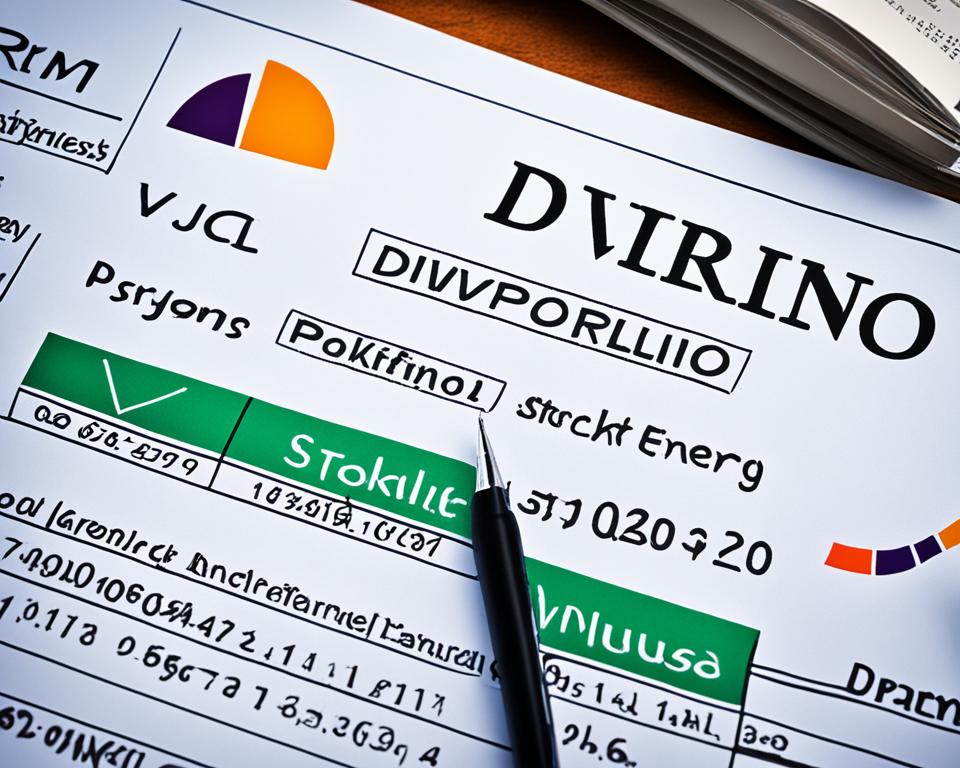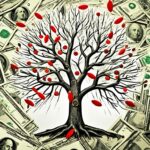With the current landscape of persistently low interest rates, the quest for meaningful yield is a significant challenge for income-focused investors. This reality has prompted a rigorous evaluation of dividend stocks vs bonds in the pursuit of viable alternatives to traditional fixed-income investments such as certificates of deposit (CDs), money market funds, and bonds. While the allure of dividend-paying stocks with their potential for income and growth is evident, it is critical for investors to grasp the distinctive risks they assume, which markedly diverge from the bond market’s profile.
Recent history provides a snapshot of these differences in risk. During the 2008 financial downturn, for example, the S&P 500 index suffered a substantial setback, while fixed-income investments like Barclay’s Aggregate Bond Index offered a contrasting positive return. Albeit dividend-oriented exchange-traded funds (ETFs), such as the Vanguard Dividend Appreciation ETF (VIG) and the Vanguard High Dividend Yield ETF (VYM), recuperated better than the broader market, they nonetheless faced pronounced drawdowns, illustrating the inherent volatility even within dividend-focused assets.
Consequently, when it comes to investing in dividend stocks vs bonds, navigating these waters requires a strategic approach that balances the pursuit of higher yields against tolerance for market fluctuations—a crucial consideration for anyone from retirees to the more aggressive growth-seeking investor.
Key Takeaways
- Income-oriented investors are increasingly considering dividend stocks as an alternative to low-yielding fixed-income investments.
- Unlike bonds, dividend stocks come with risks similar to those of the broader stock market, even though they can provide competitive yields.
- The 2008 financial crisis highlighted the lower volatility and relative safety of bond investments over stocks during market downturns.
- A balanced portfolio that includes both dividend stocks and bonds can offer a diversified strategy to manage risk and returns.
- Dividend stocks vs bonds each offer distinct benefits and risk profiles, necessitating an informed investment approach aligned with individual financial goals.
Understanding Dividend Stocks and Their Place in Your Portfolio
When venturing into the realm of the stock market, identifying the best dividend stocks for income is paramount for those seeking steady cash flows. These equities stand out for their propensity to share profits with investors, which can significantly impact one’s investment strategies and retirement planning. Before we delve into optimizing your portfolio with dividend investing strategies, let’s understand what sets these stocks apart.
Definition and Characteristics of Dividend Stocks
Dividend stocks refer to shares issued by companies that regularly return a portion of their earnings to shareholders in the form of dividends. The decision to invest in high dividend stocks versus bond yields often hinges on several key characteristics that make them particularly appealing:
- Distribution of profits directly to shareholders, providing a potential source of recurring income.
- Possession of generally lower volatility in comparison to their non-dividend-paying counterparts.
- Enhancement of an investor’s income stream, offering a buffer during economic downturns.
Investors drawn to dividend investing strategies appreciate not only the income but also the possibility of reduced market risk inherent in these types of stocks.
Role of Dividend Stocks in Long-term Wealth Creation
In the landscape of financial planning, especially when considering the best avenues for generating income, dividend stocks often become integral components. Especially for retirees, who require dependable income streams, these stocks can be allocated strategically:
- Immediate spending needs can be addressed by the predictable income from dividends.
- Portfolios can be balanced with a mix of income-generating and growth-oriented assets.
- Total return, which combines capital appreciation with dividend yield, serves to ensure sustainable finances through one’s retirement years.
Rather than having a sharp focus on high dividend stocks versus bond yields alone, savvy investors often look at the total return potential, factoring in the possibility for both income and growth.
Acknowledging the place dividend stocks hold in an investment portfolio offers the clarity necessary to leverage them for long-term financial success. The judicious selection and blending of these stocks, aligned with dividend investing strategies, can play a crucial role in the pursuit of a secure and flourishing financial future.
Demystifying Bonds as a Fixed-Income Investment
When it comes to constructing a financier’s portfolio with an eye toward stable income, the comparison of corporate bonds vs dividend stocks becomes a topic of considerable focus. With recent shifts in the economy and incessant changes in interest rates, understanding how to navigate the intricate world of bonds is paramount. Bonds, with their established role as a cornerstone in fixed-income investment strategies, offer investors a different set of characteristics and benefits than equities do, especially in terms of income generation and risk exposure.
Types of Bonds and Their Features
Within the broad category of fixed-income securities, investors encounter a myriad of bond types, each with unique features that cater to diverse investment preferences. The spectrum ranges from U.S. Treasuries, deemed among the safest due to government backing, to municipal bonds offering potential tax benefits. On the corporate front, investment-grade bonds resonate with those who prioritize credit quality, whereas high-yield bonds, colloquially known as junk bonds, entice those hunting for higher returns, albeit at a higher risk. Each type comes with its own risk-reward calculus, critical for investors choosing between dividend stocks and bonds.
- U.S. Treasuries are backed by the full faith and credit of the U.S. government, catering to risk-averse investors.
- Municipal bonds, issued by states and local governments, might offer tax exemptions, attractive to tax-conscious investors.
- Investment-grade corporate bonds possess higher credit rankings, suggesting lower risk of default.
- High-yield bonds carry lower credit ratings but offer higher interest rates to compensate for the elevated risk.
How Bonds Generate Income for Investors
Bonds present an income stream to investors through periodic interest payments, also known as coupons, which are determined by the bond’s coupon rate. This contractual obligation for regular payouts sets bonds apart, forging a predictable income pattern—a characteristic often sought by retirees and conservative investors. The return from bonds culminates upon maturity, when the issuer repays the bond’s face value. This aspect of fixed returns underpins the argument for the safety of bonds when examining how to choose between dividend stocks and bonds.
| Bond Type | Coupon Rate | Yield to Maturity | Credit Rating |
|---|---|---|---|
| U.S. Treasuries | Varies by maturity | Generally lower relative to corporate bonds | AAA |
| Municipal Bonds | Varies widely | Often lower than corporate bonds, adjusted for tax benefits | From AAA to non-rated |
| Investment-Grade Corporate Bonds | Dependent on company and duration | Competitive, depending on issuer’s creditworthiness | BBB- or higher |
| High-Yield Bonds | Higher to compensate for risk | Attractive but reflects higher risk of default | Below BBB- |
Delving into the world of bonds, with its plethora of options ranging from safe harbors to more speculative ventures, necessitates a firm grasp of key metrics like yield to maturity and the pivotal credit rating. In essence, bonds can act as a buffer, offering a form of capital preservation and fixed returns that are especially appealing amidst the vicissitudes of the market. As investors consider their portfolios and ponder on corporate bonds vs dividend stocks, the security inherent in bonds stands as a compelling counterpart to the growth potential offered by dividend stocks.
Dividend Stocks vs Bonds: Weighing the Risks and Returns
In the financial world, the debate between high dividend stocks vs bond yields continues to be a hot topic, especially when tailoring investment portfolios to meet personal financial goals. To make an informed decision, understanding the various factors impacting risk and potential returns is essential. Capitalizing on dividend vs interest income relies on an investor’s proclivity for risk, income needs, and the overall growth objectives of their portfolio. Within this context, assessing market conditions for investing in dividend stocks vs bonds becomes a pivotal part of crafting an effective investment strategy.
There’s an inherent appeal in the potential for higher gains offered by dividend stocks. The common allure lies in their dual benefit package—providing investors with regular income through dividends and the potential for equity growth. While past performance has demonstrated that dividend stocks can outpace traditional bond returns, these equities are not without their risks. They reside within the same arena as the larger stock market, influenced by fluctuations that can affect both their value and their ability to sustain or grow dividends over time.
Contrastingly, bonds are often associated with lower risk due to their fixed-income nature. They have historically provided a stabilizing effect, particularly during volatile market conditions. However, bonds are not immune to change; they possess their own brand of volatility predominantly driven by interest rate fluctuations. This relationship is shaped by the concept of duration—an indicator of a bond’s price sensitivity to interest rate changes. As interest rates rise, bond prices usually fall, potentially eroding capital for those not holding to maturity. The inverse is true when rates decline, creating capital gain opportunities for bondholders.

Building a portfolio with the right mix of dividend stocks and bonds is an exercise in balance—weighing the potential for growth against the need for predictable income. It requires continuous monitoring of the market pulse to gauge which asset class may provide optimal results under prevailing economic conditions.
| Asset Class | Risk Profile | Potential for Growth | Income Stability | Interest Rate Sensitivity |
|---|---|---|---|---|
| Dividend Stocks | Higher | Potential for significant capital appreciation | Variable, can fluctuate with company performance | Lower, as dividends can increase with inflation |
| Bonds | Lower | Limited to interest rate environment | High, with fixed interest payments | High, especially for longer-duration bonds |
When contemplating high dividend stocks vs bond yields, it is crucial to reflect on one’s investment horizon and individual circumstances. Retirees or those leaning towards capital preservation may prefer the security of bonds and their steady stream of interest income. In contrast, growth-focused investors may gravitate towards dividend stocks to benefit from potential market gains and rising dividend payouts.
Conclusively, both asset classes serve distinct roles within an investment portfolio, and the optimal mix should be customized to represent each investor’s specific risk tolerance and financial aspirations. Whether it’s about assessing market conditions for investing in dividend stocks vs bonds or gauging the right time to switch allocations, the importance of thorough research and ongoing portfolio assessment is fundamental in pursuing both wealth preservation and growth.
Income Investing: Dividend Stocks for Retirement Portfolio
For retirement savers, the stability of income is paramount. As the search for this financial bedrock intensifies, many turn to dividend stocks to anchor their retirement portfolios. An empirical approach to incorporating dividend stocks for retirement portfolio purposes can bring about a lucrative synergy of growth and income, especially when considering the best dividend stocks for income. But how do investors navigate the myriad choices to build a portfolio that not only sustains them through their golden years but also optimizes income potential?
Finding the Best Dividend Stocks for Income
Sophisticated investors often hone in on equities with proven track records, such as the Dividend Aristocrats—companies known for their longstanding history of dividend growth. These stalwarts of the stock market are renowned for offering invigorating dividends without the rollercoaster ride of volatility that afflicts many other shares. In the quest to unearth the best dividend stocks for income, investors scrutinize several facets including profitability, diligent payout ratios, and the overarching caliber of the company.
Building a Diversified Dividend-Paying Portfolio
Diversity is the linchpin of a robust dividend-paying portfolio. It’s not merely about aggregating stocks with handsome dividends, but rather fashioning a portfolio that spreads across sectors and industries. This strategic allocation reduces risk and is designed to curate a mix of stocks that complement each other. Ensuring that no individual holding has an unwieldy influence helps to stave off concentration risk, which is critical for those depending on their investments for retirement income.
| Company | Sector | Dividend Yield | Dividend Growth |
|---|---|---|---|
| Johnson & Johnson | Healthcare | 2.5% | 6% (5-Year Average) |
| Procter & Gamble | Consumer Goods | 2.8% | 5% (5-Year Average) |
| AT&T Inc. | Telecommunications | 7.0% | 2% (5-Year Average) |
| The Coca-Cola Company | Beverages | 3.0% | 3% (5-Year Average) |
Constructing a retirement portfolio centered around dividend stocks for retirement portfolio goals doesn’t happen by chance. It’s the product of meticulous planning, a keen eye for quality, and an adherence to diversification. Amidst an ever-changing market landscape, securing a flow of income through strategic stock selection remains a cornerstone of retirement planning.
Interest Rates and Their Impact on Bonds and Dividend Stocks
As investors strive for the ideal balance in their portfolios, especially when comparing dividend stocks vs bonds, understanding how interest rates affect these asset classes is fundamental. The tug of war between seeking safety in bonds and aiming for growth through dividend stocks becomes even more pronounced in changing interest rate environments. To adeptly choose between dividend stocks and bonds, one must consider how each responds to interest rate shifts.
Interest Rates and Bond Price Volatility
The bond market is particularly sensitive to the tides of interest rates. As rates rise, new bonds are often issued at higher yields, causing the price of existing bonds to dip in order to remain competitive in the marketplace. This inverse relationship showcases the pivotal role of duration—a measure of the bond’s sensitivity to rate changes. Duration indicates not just the time until a bond’s maturity but also encapsulates the weighted average time until all cash flows are received. Bonds with longer durations exhibit more pronounced price volatility when interest rates shift.
| Bond Duration | Interest Rate Impact | Price Volatility |
|---|---|---|
| Short-term | Lesser increase | Lower Volatility |
| Intermediate | Moderate increase | Moderate Volatility |
| Long-term | Higher increase | Higher Volatility |
How Dividend Stocks Respond to Changes in Interest Rates
Dividend stocks, on the other hand, might respond to interest rate transitions in a more multifaceted way. Rising rates can increase borrowing costs for companies, which may influence their operational costs and, by extension, their profits and dividend payments. Yet, some dividend-paying companies, particularly those in sectors like utilities or real estate, may still maintain their attractiveness due to their above-average yield and potential for dividend growth. Consequently, the way dividend stocks react to interest rate changes can offer a mix of challenges and opportunities for investors focused on long-term total returns.
- Rising Rates: May reduce the present value of future dividend payments leading to a reevaluation of stock prices.
- Established Dividend Payers: Often have steady cash flows and may be better positioned to weather increasing rates.
- Sector Specificity: Certain sectors may be more resistant to interest rate changes, making stock selection critical.
Weighing the risks and potential rewards when investing in dividend stocks vs bonds is a nuanced process, particularly for those aiming to construct a portfolio aimed at both income and growth. The interplay between interest rates and these investment vehicles informs strategic asset allocation and underscores the importance of staying informed on market trends and economic forecasts.
Parsing the Yield: High Dividend Stocks vs Bond Yields
The perennial debate between high dividend stocks vs bond yields is more than just a question of current income—it’s a complex assessment of total return investing principles. This analysis becomes critical in light of 2022’s spike in bond yields, presenting income investors with yields that haven’t been seen in over a decade. Such attractive rates may compel a conservative shift towards bonds; however, high dividend stocks continue to wield the dual allure of potential capital gains and dividends. To ascertain the optimal yield strategy within the treacherous currents of market dynamics, we sift through a rich data tapestry, assessing not just immediate returns but the future horizons of income and growth.
An insightful way to contrast the yields of dividend stocks and bonds is through the lens of recent historical performance, encapsulated in the table below. While higher bond yields could be enticing for those focused solely on income, high dividend stocks promise the additional benefit of portfolio growth—especially in an environment where dividends rise in concert with corporate earnings. Yet, investing is never devoid of risk. Often, what qualifies as the superior investment choice echos the ever-changing melody of economic conditions.
| Investment Type | Yield | Income Potential | Capital Growth | Market Influence |
|---|---|---|---|---|
| High Dividend Stocks | Variable | Dividend payouts subject to company performance | Higher growth potential with market appreciation | Subject to broader stock market volatility |
| Bond Yields | Fixed | Stable income via interest payments | Primarily from interest, limited capital appreciation | Significant interest rate sensitivity |
Converging on the principle of total return investing, savvy investors are mindful that the terrain of high dividend stocks looks appealing not just for the immediate yield it provides but also for its propensity to elevate one’s portfolio through capital appreciation. Even as bond investors revel in newfound yields, the finite nature of their capital growth places an inherent ceiling on overall portfolio potential. Therefore, determining the preeminent investment avenue requires a discerning eye towards both the present yield and anticipated total return, taking care to marry investment objectives with market realities.
In conclusion, while soaring bond yields might shine during periods of market turmoil as safe harbors, the steadfast sails of high dividend stocks catch the winds of market growth, propelling investors towards potentially richer shores of total return investing. Yet, as economic conditions shift, so too should an investor’s strategy—requiring continual monitoring and reevaluation of the balance between seeking safety in bonds or embracing growth with dividend stocks.
Total Return Investing: Dividends and Capital Gains
In the pursuit of a robust investment strategy, savvy investors often focus on the concept of total return vs yield. While yield provides an immediate picture of the income an investment generates, total return broadens the perspective to encompass both the income and capital gains an asset may achieve over time. This comprehensive view is particularly vital in the realm of dividend investing strategies, where the balance between steady income and potential capital growth is key to maximizing wealth.
Looking Beyond Current Yields to Total Returns
Yield, representing the income returned on an investment, is often a focal point for investors; however, relying solely on current yields when evaluating opportunities may present an incomplete picture. This is especially true for those investing in dividend-paying stocks, where the prospect of capital gains can significantly enhance total returns. A long-term approach that accounts for both dividends and the potential for stock appreciation allows investors to capture the complete benefit of their investments.
Combining Dividend Income and Growth for Total Return
Dividend investing strategies that emphasize total return facilitate prospects not only for present income but also for future wealth. By choosing companies with a track record of dividend growth and capital appreciation, investors can benefit from the dual streams of ongoing dividend income and increased valuation over time. This dual benefit is what differentiates total return investing from a yield-only approach, offering a potentially more fruitful path to achieving financial goals.
| Investment Choice | Yield | Historical Capital Gains | Total Return Focus |
|---|---|---|---|
| High Dividend Stocks | Stable to High | Varies; can be significant over time | Income + Growth |
| Growth Stocks | Typically Low or None | High | Growth |
| Bonds | Stable to High | Minimal; bound by interest rates | Income |
Adopting a total return strategy often requires a paradigm shift, where dividends are not merely a source of current income but also a building block for longer-term growth potential. By harmonizing the stability of dividend payments with the dynamism of capital gains, total return investing may serve as an effective strategy for those seeking to attain substantial financial milestones, including a resilient and prospering retirement portfolio.
Dividends vs Interest Income: Understanding the Tax Implications
Investors focusing on portfolio income have to consider the tax implications of investing, particularly when contrasting dividend vs interest income. How these earnings are taxed can significantly influence the net returns an investor realizes, making familiarity with the current tax landscape crucial. While dividends can offer tax efficiencies, certain bond investments carry tax benefits that may be equally compelling, particularly in the context of long-term investment strategies.
Tax Treatment of Dividend Income
The Internal Revenue Service (IRS) differentiates between ordinary dividends and qualified dividends. The latter, which must meet specific criteria, are taxed at the more favorable long-term capital gains rates—significantly lower than the rates applied to ordinary income or non-qualified dividends. This preferential tax structure profoundly impacts an investor’s tax obligation, rendering qualified dividends a potent tool for those seeking tax-efficient yield.
Tax Advantages of Certain Bond Investments
Municipal bonds, often referred to as “munis,” hold a place of prominence for their unique tax treatment. Income from these bonds is often exempt from federal income taxes, and if the bondholder resides in the state where the bond was issued, it may also be exempt from state taxes. This dual exemption can result in substantial tax savings and is a pivotal consideration for investors appraising the trade-offs between high-yielding bonds and dividend stocks.
The comparative table below illustrates the different tax treatments for dividend and interest income, underscoring the key role taxes play in investment decisions:
| Income Type | Tax Rate | Notes |
|---|---|---|
| Qualified Dividends | 0%, 15%, or 20% | Taxed at favorable long-term capital gains rates |
| Ordinary Dividends | Up to 37% | Taxed as ordinary income at individual’s tax rate |
| Interest Income | Up to 37% | Taxed as ordinary income |
| Municipal Bond Interest | Often 0% federally | May also be exempt from state and local taxes if issued in the bondholder’s state of residence |
Integrating dividend vs interest income considerations into an investor’s strategy is more than a mere exercise in yield comparison—it demands a keen understanding of how each will be treated come tax season. Thus, optimizing for post-tax returns is as integral to investment strategies as the selection of the assets themselves.
Assessing Market Conditions for Investing in Dividend Stocks vs Bonds
Strategically navigating the financial landscape necessitates a keen awareness of market conditions, particularly when assessing market conditions for investing in dividend stocks vs bonds. Interest rates, economic growth forecasts, and inflation trends are all pivotal factors that dramatically influence the relative appeal of these two investment classes.
As we dissect these conditions, it is worthy to note that dividend stocks are often lauded for their potential for growth and income. Considerations like the health of the economy, consumer confidence, and the buoyancy of corporate earnings can have profound implications on these stocks. A booming economy may bolster corporate profits and, in turn, dividends — making dividend stocks an attractive option.
However, the bond market responds to different cues. With interest rates at historically low levels in recent years, bond yields have concurrently trended lower. This dynamic has shifted as central banks signal a move away from policies that accommodate growth to those that suppress inflation. As rates inch upwards, bond prices tend to drop. Nonetheless, higher rates may eventually lead to higher yields for new bonds, potentially making them more competitive against dividend stocks for income-seeking portfolios.
Additionally, economic cooldowns or recessions can lead to a preference for the relative safety of bonds over stocks. Here, the primary concern for investors is capital preservation, as opposed to growth. Bonds, especially those with higher credit ratings, provide a fixed-income stream and may be less sensitive to economic downturns, unlike dividend stocks, which can reduce or eliminate payouts in hard times.

Reflecting back on historical data, we can observe periods where dividend stocks have provided superior total returns compared to bonds. Yet, these times are frequently accompanied by a more robust economy and more abundant risk appetite among investors. Therefore, the decision to invest in one or the other is not static but should evolve with the ongoing assessment of the market’s condition.
Furthermore, some investors might examine yield curves to gauge relative values between short and long-term investments. A flattening curve may signal a transition in economic cycles, thereby impacting decisions on where to allocate capital for those pondering investing in dividend stocks vs bonds.
The table below outlines key metrics that investors may employ to evaluate current market conditions relevant to both asset classes:
| Factor | Dividend Stocks | Bonds |
|---|---|---|
| Economic Growth | May enhance corporate earnings and dividends | Yields may rise with inflation, increasing future bond returns |
| Inflation | Can erode real returns but growth may keep pace | Fixed payments may lose value, but TIPS can offer a hedge |
| Interest Rates | Affected indirectly through corporate borrowing costs | Directly influences bond prices and yields |
| Market Sentiment | Impact on stock prices can affect dividend yields | Investor demand for safety can influence bond prices |
In sum, a thorough assessment of these and other market conditions is fundamental when deciding how to allocate investment funds between dividend stocks and bonds. An investor’s approach should match their individual risk tolerance, investment horizon, and goals, while staying adaptive to the ever-changing economic environment.
Corporate Bonds vs Dividend Stocks: A Comparative Analysis
Our in-depth comparative analysis of corporate bonds vs dividend stocks aims to elucidate the finer points of these investment vehicles concerning credit risk, expected returns, and liquidity. In the intricate ballet of capital markets, investors often face the conundrum of choosing between the two, each with its distinct characteristics and implications for an investment portfolio.
Corporate bonds, touted for their relative safety, pledge repayment ahead of equity, placing them closer to the lifeline in an issuer’s capital structure. This perceived security becomes a beacon during times of financial distress. Dividend stocks, conversely, offer the potential for higher returns. These returns, however, come with a catch: increased risk associated with their subordinate position in case of bankruptcy. The dividends themselves are not set in stone; a company’s fortunes can both lift and limit this income channel.
Delineating the contrast in credit risk profiles is at the heart of this discussion. Corporate bonds are generally associated with lower credit risk compared to dividend stocks. While rigorous analysis of an issuer’s solvency can help mitigate risks, bondholders have the comfort of legal protection for their investments. On the stock side of the equation, shareholders’ fate is tied to the company’s success; as such, stocks are reflective of both a company’s profitability and the broader market’s pulses.
The expected returns from these assets tend to align with their risk profiles. Bonds often yield a steady but potentially lower return, ideal for those who value predictability over speculation. To compare, dividend stocks do not guarantee dividends, and their prices are susceptible to market shocks. However, their potential for yield growth over time is a lure for the investor willing to ride the volatility waves in exchange for possible higher payouts.
Our analysis would be remiss without touching upon liquidity concerns. Corporate bonds, although they can be traded in secondary markets, may not always match the bustling liquidity of their equity counterparts. Investors prioritizing flexible entry and exit positions might find dividend stocks more compelling in this regard.
| Investment Type | Credit Risk | Expected Returns | Liquidity |
|---|---|---|---|
| Corporate Bonds | Lower | Consistent, fixed income | Varies, generally less liquid than stocks |
| Dividend Stocks | Higher | Variable, potentially higher over time | Generally high |
Comparing corporate bonds vs dividend stocks is a task that transcends mere number crunching. It involves a forward-looking gauge of market sentiments, an assessment of the individual’s investment timeframe, and a keen sense of timing when entering or exiting positions. Astute investors weigh these factors, blending considerations of creditworthiness and market outlook in their decision-making process. To sum up, each asset class offers distinct features and potential benefits, and a balanced investment portfolio might well include a carefully thought-out mix of both.
How to Choose Between Dividend Stocks and Bonds
Investors seeking fruitful portfolios are often at crossroads when deciding how to choose between dividend stocks and bonds. This decision hinges on multiple facets of their financial plans, where the choice reflects their tolerance for risk, their desire for income, and their long-term growth aspirations. This intricate selection process is crucial as it could lead to either a stable income source or the potential for greater returns through careful asset allocation.
While bonds traditionally provide fixed income and protection of capital, dividend stocks offer the prospect of yield combined with capital appreciation. However, the inherent volatility of the stock market and varying economic phases necessitate astute assessment and tactical asset allocation, especially regarding allocating assets based on market lifecycle. Balancing the scales between these investment options requires diving into one’s investment profile and understanding the influence of market dynamics on both asset classes.
Evaluating Personal Investment Goals and Risks
Each investor’s journey is unique, with varied objectives shaping their portfolio. Evaluating personal investment goals involves a deep understanding of whether the priority lies in capital preservation and steady income, often the domain of bonds, or whether one is in a position to pursue growth, associated more closely with dividend stocks. The evaluation process includes understanding timelines: retirees may seek immediate income, while younger investors might focus on long-term financial growth. Risk tolerance also influences this decision, as comfort levels with the stock market’s fluctuations could pave the way for investment choices aligned with an individual’s financial landscape.
Allocating Assets Based on Market Lifecycle
The market lifecycle plays a pivotal role in dictating asset allocation strategies. As economic conditions evolve, so too can the relative attractiveness of dividend stocks and bonds. In burgeoning economic climates, dividend stocks may flourish, driving a higher potential for growth. Conversely, in times of market retreat or high volatility, the perceived safety of bonds often becomes more appealing to investors. Crafting a diversified portfolio means watching the market closely and dynamically adjusting the mix between equities and fixed income to align with the shifting tides of the economy and interest rate movements.
The Resilience of Bonds During Market Downturns
When assessing market conditions for investing in dividend stocks vs bonds, the stability and resilience of bonds during economic downturns cannot be overlooked. This resilience is a result of the structure of bonds as a fixed-income investment, with obligations for issuers to make regular interest payments and return the principal upon maturity. Unlike the equity market, where a company’s dividend payments can be reduced or halted altogether according to their profitability and cash flow, bonds offer legal protection to investors for at least the return of their initial investment and any agreed-upon interest, barring default.
Historical evidence paints a vivid picture of this stability. In tumultuous financial periods, such as the 2007-2009 crisis, investors who allocated funds to high-quality, investment-grade bonds experienced comparatively lower default rates and were shielded from the severe capital devaluation faced by those with equity-heavy portfolios. This protective characteristic of bonds is highlighted in the table below which reflects on notable financial downturns where bonds have demonstrated considerate resilience:

| Market Downturn | Bond Performance | Equity Performance |
|---|---|---|
| 2007-2009 Financial Crisis | Bonds: Low Default Rates | Equities: Significant Dividend Cuts |
| Dot-com Bubble Burst (2000-2002) | Bonds: Stable Returns | Equities: Substantial Losses |
| Early 1990s Recession | Bonds: Favorable Yield | Equities: Reduced Payouts |
The emphasis on capital preservation during economic uncertainty is a fundamental reason why many advisors recommend bonds as a key component of any well-balanced portfolio. As we navigate through different economic cycles, bonds consistently affirm their role in providing a safeguard against market volatility, thereby underscoring the importance of bonds in stabilizing an investment portfolio over time.
Dividend Investing Strategies for Optimal Income
For those who aim to enhance their investment income, prudent dividend investing strategies are essential. Often, these strategies revolve around identifying stocks with a history of consistent and rising dividend payouts, such as Dividend Aristocrats and Kings. These investments can underpin a portfolio, offering the potential for both a steady income stream and long-term capital appreciation. However, investors can go a step further by diversifying their income-generating assets to include Real Estate Investment Trusts (REITs) and Master Limited Partnerships (MLPs), which may offer high yields and unique tax advantages.
Seeking Out Dividend Aristocrats and Kings
Investors aiming for reliable dividends often focus on Dividend Aristocrats and Kings for good reason. These companies have not only paid but also increased their dividends for at least 25 consecutive years (Aristocrats) or 50 years (Kings), signalling financial stability and shareholder-friendly policies. A portfolio enriched with these trusted entities can provide a cushion during economic uncertainties and can be instrumental for those prioritizing income and moderate growth.
- **Dividend Aristocrats**: E.g., Procter & Gamble and Johnson & Johnson have persistently increased dividends, demonstrating resilience across market cycles.
- **Dividend Kings**: Companies like Coca-Cola and 3M stand as testaments to exemplary corporate endurance and long-term shareholder return.
The commitment of these companies to return value to shareholders makes them attractive targets for a dividend-focused investment approach.
Incorporating REITs and MLPs into Dividend Strategies
REITs and MLPs are unique investment vehicles that can be effective components of a dividend investing strategy, often offering attractive yields and certain tax benefits. REITs, which invest in various kinds of real estate or mortgages, are required by law to distribute a majority of their taxable income to shareholders, typically leading to higher dividend yields. MLPs, which often operate in the energy sector, provide a tax-advantaged income stream, as a substantial part of the payouts are considered return on capital and may be tax-deferred.
- **REITs**: They provide diversification beyond conventional stocks and bonds with exposure to commercial, industrial, or residential real estate.
- **MLPs**: Focused primarily on energy infrastructure, MLPs offer a way to invest in a staple economic sector with the potential for yield and growth.
By integrating these assets into a portfolio, investors can tap into sectors that not only provide regular income but also hold the potential for longer-term capital gain.
| Asset Type | Yield Potential | Tax Consideration | Growth Prospect |
|---|---|---|---|
| Dividend Aristocrats | Stable | Qualified dividends taxed at capital gains rates | Moderate |
| Dividend Kings | Stable to High | Qualified dividends taxed at capital gains rates | Moderate to High |
| REITs | High | Distributions not taxed at corporate level; part may be taxed as ordinary income | Variable, dependent on real estate market |
| MLPs | High | Portion of distribution may be tax-deferred return on capital | Subject to commodity price fluctuations |
Investors employing dividend investing strategies that include a mix of Dividend Aristocrats and Kings, alongside REITs and MLPs, are positioned to capitalize on an income-focused portfolio while maintaining avenues for growth. By balancing these assets, investors can strive for consistent payouts and benefit from diverse sectors that may enhance overall portfolio performance amidst fluctuating market conditions.
Conclusion
Deciphering the conundrum of investing in dividend stocks vs bonds requires astute financial acumen, assessing not just the potential rewards but also the accompanying risks that each asset class carries. Dividend stocks beckon with their seductive promise of capital gains coupled with ongoing income, making them particularly alluring for those with a long-term investment horizon who can navigate the inherent volatility of the stock market. For such investors, aligning with formidable dividend growth strategies can lead to optimal income generation and robust portfolio expansion.
Conversely, the world of bonds presents a more serene landscape with its structured interest payouts, offering a harbor of predictability that is highly prized by those who prioritize capital preservation and stability, particularly in turbulent market conditions. Such attributes establish bonds as stalwarts in the face of downturns, protecting portfolios from the full brunt of market unrest. Choosing between dividend stocks and bonds is thus a delicate balance, finely tuned to the individual investor’s needs, risk appetite, and financial aspirations.
In conclusion, the key to a resolute and resilient investment approach lies in embracing the distinctive characteristics of both dividend stocks and bonds. By constructing a diversified investment toolkit honed by insightful strategies for optimal income, investors can deftly steer their financial course. Whether seeking the dynamic growth of dividend stocks or the steadfast security of bonds, the judicious investor weighs these options, forging a path tailored to their unique situational contours and ensuring endurance across the full spectrum of market cycles.
FAQ
How do dividend stocks compare to bonds and other fixed-income investments?
Dividend stocks are equities that provide income through dividend payments and potential capital growth, whereas bonds and other fixed-income investments typically offer regular interest payments and greater capital preservation. Dividend stocks might offer higher total returns but with greater volatility, while bonds often provide stable income with lower risk.
What are the characteristics of dividend stocks?
Dividend stocks are issued by companies that regularly distribute a portion of earnings to shareholders. Key characteristics include the potential for income through dividends, possibility of capital appreciation, and a generally lower volatility compared to non-dividend-paying stocks.
How can dividend stocks contribute to long-term wealth creation?
Dividend stocks can contribute to long-term wealth by providing a recurring income stream and the prospect for capital growth. They’re especially beneficial within a retirement portfolio, where they can offer near-term income and contribute to overall portfolio growth over time.
What types of bonds are available to investors?
Investors have access to various types of bonds, including U.S. Treasuries, corporate bonds, municipal bonds, and more. Each type has unique features such as differing levels of risk, tax implications, and yield.
How do bonds generate income for investors?
Bonds generate income through regular interest payments known as coupon payments. At the bond’s maturity, investors are repaid the face value of the bond by the issuer. This regular income stream is the primary return for bond investors.
What are the risks and returns associated with dividend stocks compared to bonds?
Dividend stocks typically come with higher volatility and the potential for greater total returns, which include dividend income and capital gains. However, dividends are not guaranteed. Bonds generally offer lower but more predictable returns through fixed interest payments, albeit with interest rate risk affecting their market value.
How do interest rates affect bonds and dividend stocks?
Interest rates have a direct impact on bonds as they affect bond prices inversely; when interest rates rise, bond prices usually fall, and vice versa. Dividend stocks can also be influenced by interest rates as they can affect a company’s cost of borrowing, profitability, and the attractiveness of dividend yields relative to bond yields.
When comparing high dividend stocks and bond yields, which should investors prefer?
Preference between high dividend stocks and bond yields depends on individual investment objectives, risk tolerance, and market conditions. High dividend stocks offer the potential for income plus capital gains, while bonds offer a fixed interest income. Market conditions and the current yield environment are crucial factors in making this choice.
Why should investors consider total returns in their investment decisions?
Considering total returns is important because it accounts for both the income generated and any capital gains or losses. This approach helps investors understand the overall performance of their investments, beyond just the yield, which is crucial for long-term financial planning and stability.
What are the tax implications of dividends versus interest income?
Qualified dividends often benefit from lower tax rates than ordinary income, such as bond interest, which is taxed at an individual’s marginal tax rate. Certain bond investments, like municipal bonds, may also offer tax advantages by being exempt from federal, and possibly state, taxes.
How should investors assess market conditions when choosing between dividend stocks and bonds?
Investors should assess market conditions, including interest rate trends, economic cycles, and inflation expectations, which can influence the performance of dividend stocks and bonds. This helps tailor the asset allocation to better match their investment goals and risk tolerance.
In the context of corporate bonds versus dividend stocks, which are less risky?
Corporate bonds are generally considered less risky than dividend stocks because they have precedence over equity in terms of repayment during financial distress or bankruptcy. However, this may come at the cost of lower potential returns compared to dividend stocks.
How can investors align dividend stocks and bonds with their personal investment goals?
Investors should evaluate their need for capital growth versus income, risk tolerance, and investment horizon. A balanced approach may involve a mix of both dividend stocks and bonds to achieve desired stability and growth, with asset allocation adjusted according to market lifecycles and personal goals.
How do bonds perform during market downturns compared to stocks?
Bonds tend to be more resilient during market downturns, providing stable income and capital preservation due to their fixed-income nature and the legal obligation to repay principal at maturity. In contrast, stocks can experience significant volatility and potential dividend cuts.
What are effective dividend investing strategies for optimal income?
Effective strategies include investing in Dividend Aristocrats and Kings known for their long histories of increasing dividends, as well as diversifying into REITs and MLPs, which offer high yields and special tax considerations. This provides a mix of reliability in income and opportunities for growth.












